2014 Peugeot Boxer weight
[x] Cancel search: weightPage 5 of 240
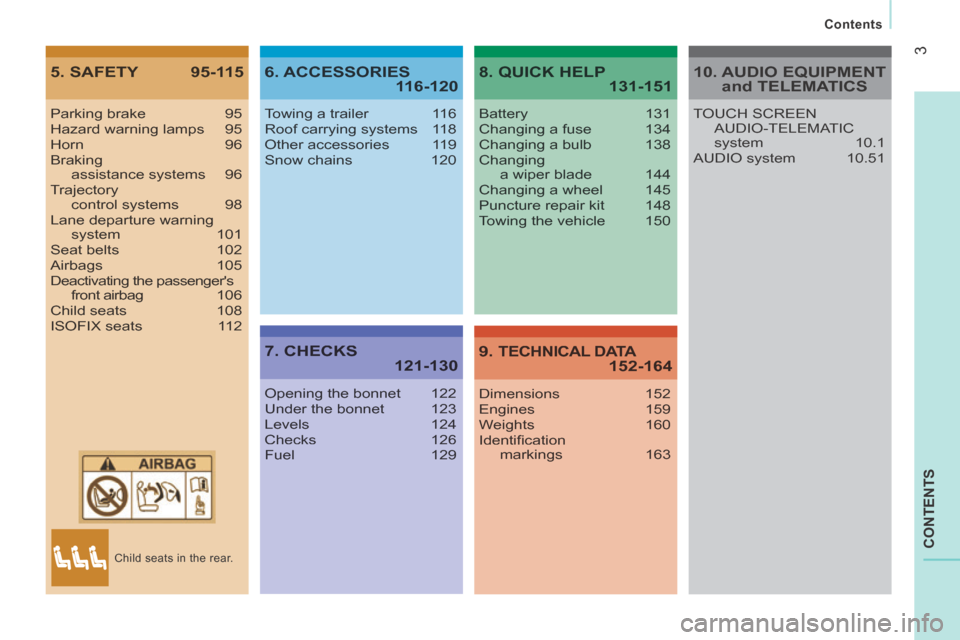
3
Contents
CONTENTS
5. SAFETY 95-1156. ACCESSORIES 116-120
7. CHECKS 121-130
8. QUICK HELP 131-151
9. TECHNICAL DATA 152-164
Parking brake 95Hazard warning lamps 95Horn 96Braking assistance systems 96Trajectory control systems 98Lane departure warning system 101Seat belts 102Airbags 105Deactivating the passenger's front airbag 106Child seats 108ISOFIX seats 112
Towing a trailer 116Roof carrying systems 118Other accessories 119Snow chains 120
Opening the bonnet 122Under the bonnet 123Levels 124Checks 126Fuel 129
Battery 131Changing a fuse 134Changing a bulb 138Changing a wiper blade 144Changing a wheel 145Puncture repair kit 148Towing the vehicle 150
Dimensions 152Engines 159Weights 160Identifi cation markings 163
10. AUDIO EQUIPMENT and TELEMATICS
TOUCH SCREEN AUDIO-TELEMATIC system 10.1AUDIO system 10.51
Child seats in the rear.
Page 12 of 240
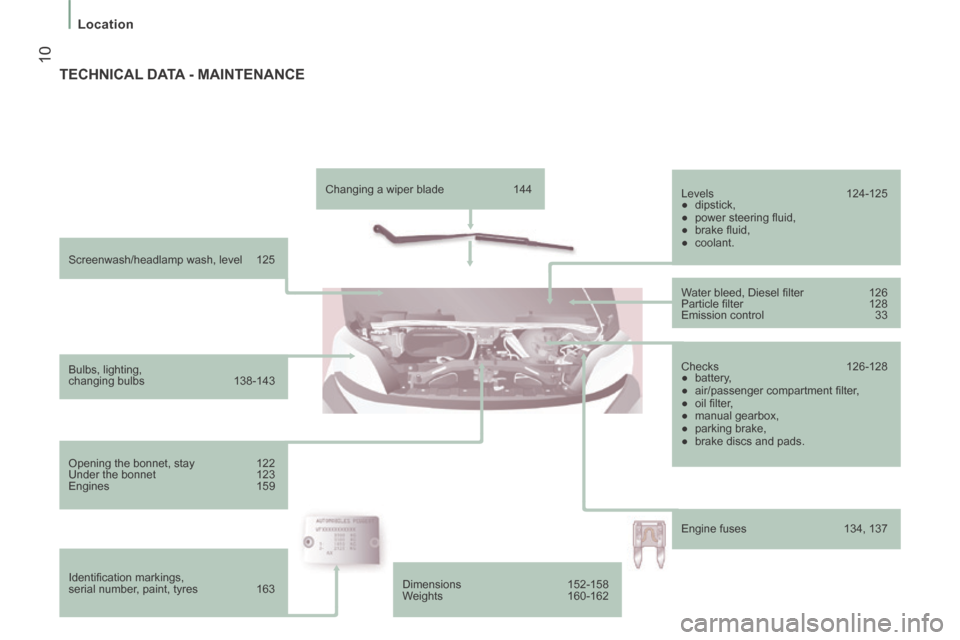
10
Location
Screenwash/headlamp wash, level 125
Bulbs, lighting,
changing bulbs 138-143
Opening the bonnet, stay 122
Under the bonnet 123
Engines 159
Identifi cation markings,
serial number, paint, tyres 163 Changing a wiper blade
144
Levels 124-125
● dipstick,
● power steering fl uid,
● brake fl uid,
● coolant.
Water bleed, Diesel fi lter 126
Particle fi lter 128
Emission control 33
Checks 126-128
● battery,
● air/passenger compartment fi lter,
● oil fi lter,
● manual gearbox,
● parking brake,
● brake discs and pads.
Engine fuses 134, 137
TECHNICAL DATA - MAINTENANCE
Dimensions 152-158
Weights 160-162
Page 72 of 240
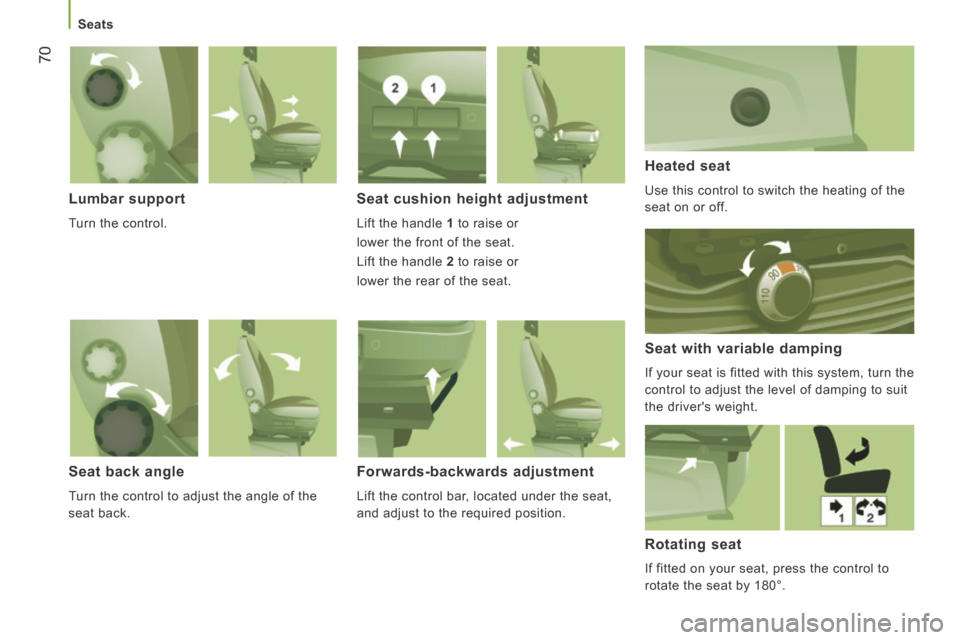
70
Seats
Lumbar support
Turn the control.
Seat cushion height adjustment
Lift the handle 1 to raise or
lower the front of the seat.
Lift the handle 2 to raise or
lower the rear of the seat.
Heated seat
Use this control to switch the heating of the
seat on or off.
Seat with variable damping
If your seat is fitted with this system, turn the
control to adjust the level of damping to suit
the driver's weight.
Seat back angle
Turn the control to adjust the angle of the
seat back.
Forwards-backwards adjustment
Lift the control bar, located under the seat,
and adjust to the required position.
Rotating seat
If fitted on your seat, press the control to
rotate the seat by 180°.
Page 101 of 240
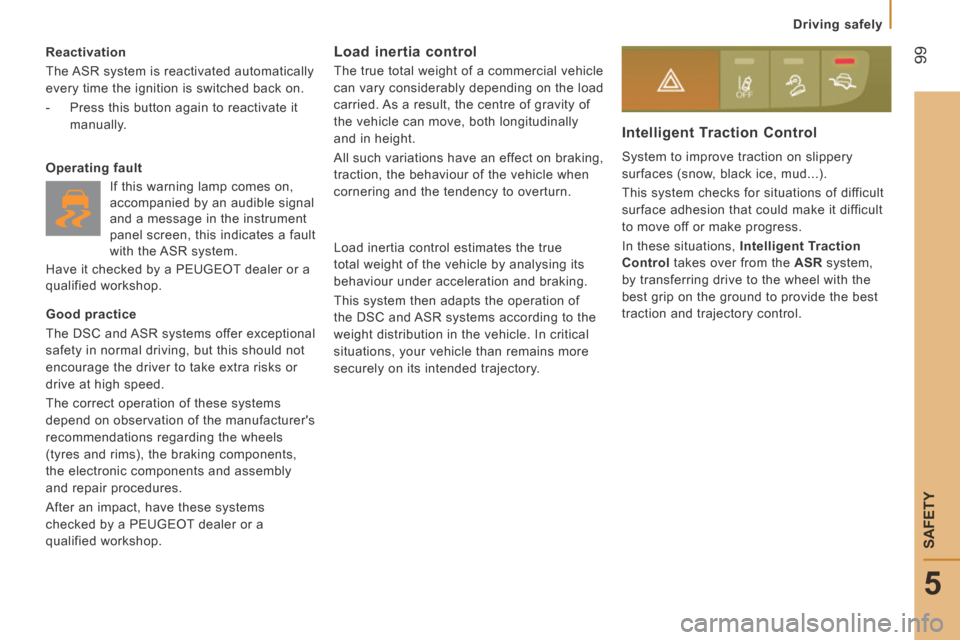
99
5
Driving safely
SAFETY
Reactivation
The ASR system is reactivated automatically
every time the ignition is switched back on.
- Press this button again to reactivate it manually.
Operating fault
If this warning lamp comes on,
accompanied by an audible signal
and a message in the instrument
panel screen, this indicates a fault
with the ASR system.
Have it checked by a PEUGEOT dealer or a
qualified workshop.
Good practice
The DSC and ASR systems offer exceptional
safety in normal driving, but this should not
encourage the driver to take extra risks or
drive at high speed.
The correct operation of these systems
depend on observation of the manufacturer's
recommendations regarding the wheels
(tyres and rims), the braking components,
the electronic components and assembly
and repair procedures.
After an impact, have these systems
checked by a PEUGEOT dealer or a
qualified workshop.
Intelligent Traction Control
System to improve traction on slippery
surfaces (snow, black ice, mud...) .
This system checks for situations of difficult
surface adhesion that could make it difficult
to move off or make progress.
In these situations, Intelligent Traction
Control takes over from the ASR system,
by transferring drive to the wheel with the
best grip on the ground to provide the best
traction and trajectory control.
Load inertia control
The true total weight of a commercial vehicle
can vary considerably depending on the load
carried. As a result, the centre of gravity of
the vehicle can move, both longitudinally
and in height.
All such variations have an effect on braking,
traction, the behaviour of the vehicle when
cornering and the tendency to overturn.
Load inertia control estimates the true
total weight of the vehicle by analysing its
behaviour under acceleration and braking.
This system then adapts the operation of
the DSC and ASR systems according to the
weight distribution in the vehicle. In critical
situations, your vehicle than remains more
securely on its intended trajectory.
Page 110 of 240
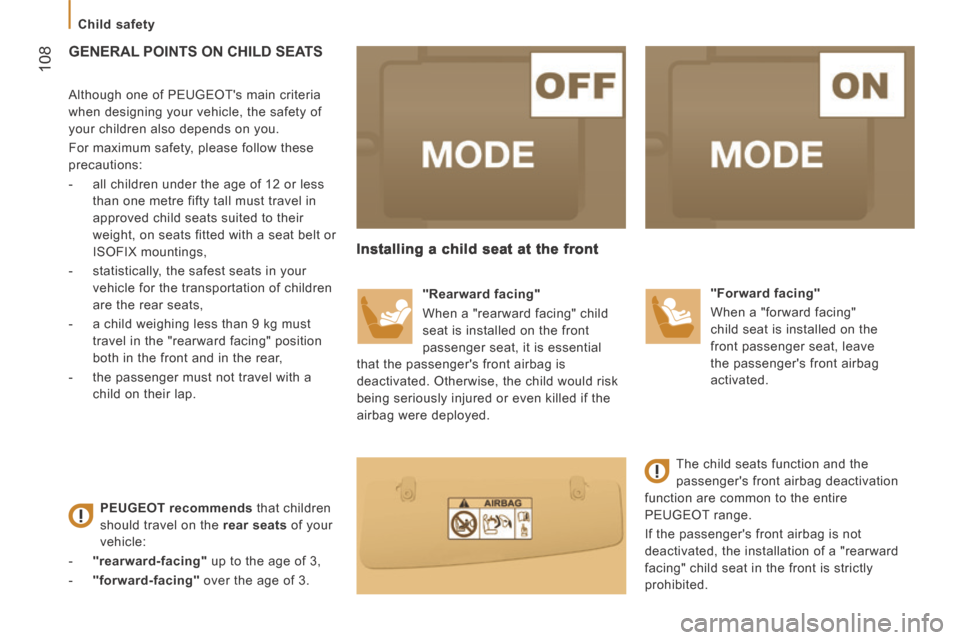
108
Child safety
GENERAL POINTS ON CHILD SEATS
Although one of PEUGEOT's main criteria
when designing your vehicle, the safety of
your children also depends on you.
For maximum safety, please follow these
precautions:
- all children under the age of 12 or less than one metre fifty tall must travel in
approved child seats suited to their
weight, on seats fitted with a seat belt or
ISOFIX mountings,
- statistically, the safest seats in your vehicle for the transportation of children
are the rear seats,
- a child weighing less than 9 kg must travel in the "rearward facing" position
both in the front and in the rear,
- the passenger must not travel with a child on their lap.
Installing a child seat at the front
"Rearward facing"
When a "rearward facing" child
seat is installed on the front
passenger seat, it is essential
that the passenger's front airbag is
deactivated. Otherwise, the child would risk
being seriously injured or even killed if the
airbag were deployed. "Forward facing"
When a "forward facing"
child seat is installed on the
front passenger seat, leave
the passenger's front airbag
activated.
PEUGEOT recommends that children
should travel on the rear seats of your
vehicle:
- "rearward-facing" up to the age of 3,
- "forward-facing" over the age of 3. The child seats function and the
passenger's front airbag deactivation
function are common to the entire
PEUGEOT range.
If the passenger's front airbag is not
deactivated, the installation of a "rearward
facing" child seat in the front is strictly
prohibited.
Page 116 of 240
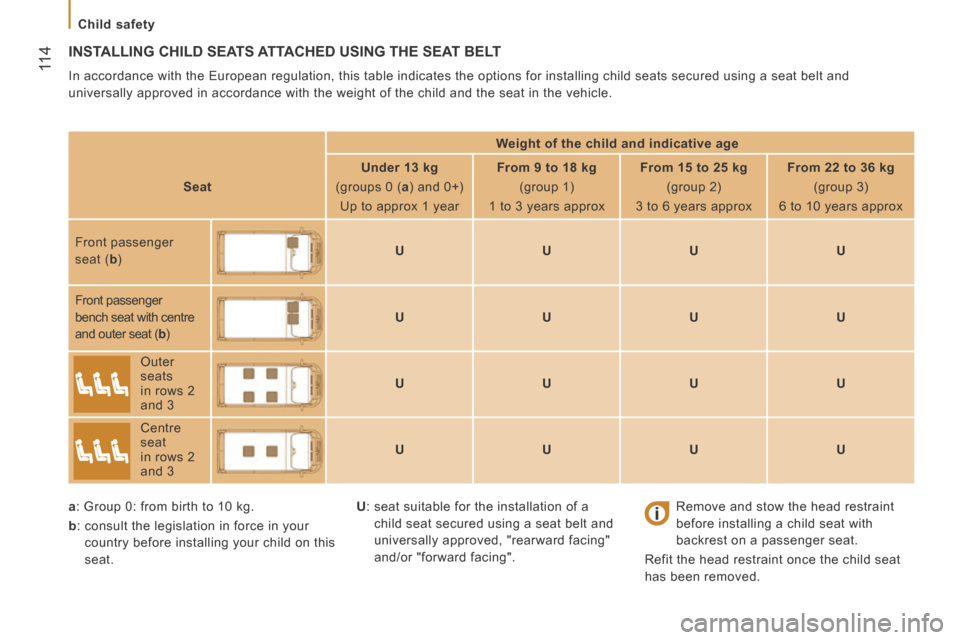
11 4
Child safety
INSTALLING CHILD SEATS ATTACHED USING THE SEAT BELT
In accordance with the European regulation, this table indicates the opt\
ions for installing child seats secured using a seat belt and
universally approved in accordance with the weight of the child and the \
seat in the vehicle. Weight of the child and indicative age
Seat Under 13 kg
(groups 0 ( a ) and 0+)
Up to approx 1 year From 9 to 18 kg
(group 1)
1 to 3 years approx From 15 to 25 kg
(group 2)
3 to 6 years approx From 22 to 36 kg
(group 3)
6 to 10 years approx
Front passenger
seat ( b ) U
U U U
Front passenger
bench seat with centre
and outer seat ( b ) U
U U U
Outer
seats
in rows 2
and 3 U
U U U
Centre
seat
in rows 2
and 3 U
U U U
a : Group 0: from birth to 10 kg.
b : consult the legislation in force in your
country before installing your child on this
seat. Remove and stow the head restraint
before installing a child seat with
backrest on a passenger seat.
Refit the head restraint once the child seat
has been removed.
U
: seat suitable for the installation of a
child seat secured using a seat belt and
universally approved, "rearward facing"
and/or "forward facing".
Page 118 of 240
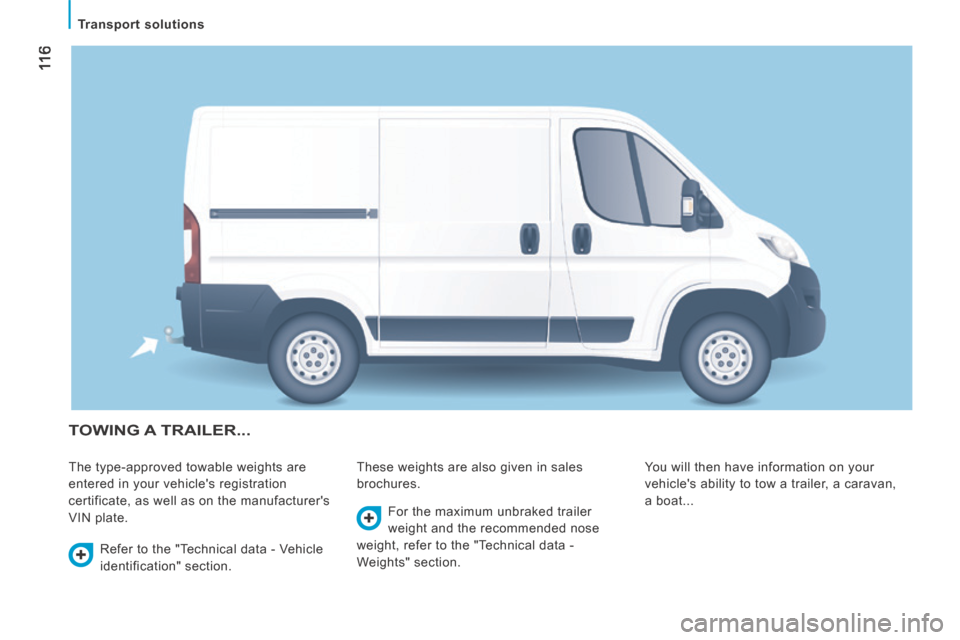
11 6
Transport solutions
TOWING A TRAILER...
The type-approved towable weights are
entered in your vehicle's registration
certificate, as well as on the manufacturer's
VIN plate. These weights are also given in sales
brochures.
You will then have information on your
vehicle's ability to tow a trailer, a caravan,
a boat...
Refer to the "Technical data - Vehicle
identification" section. For the maximum unbraked trailer
weight and the recommended nose
weight, refer to the "Technical data -
Weights" section.
Page 119 of 240
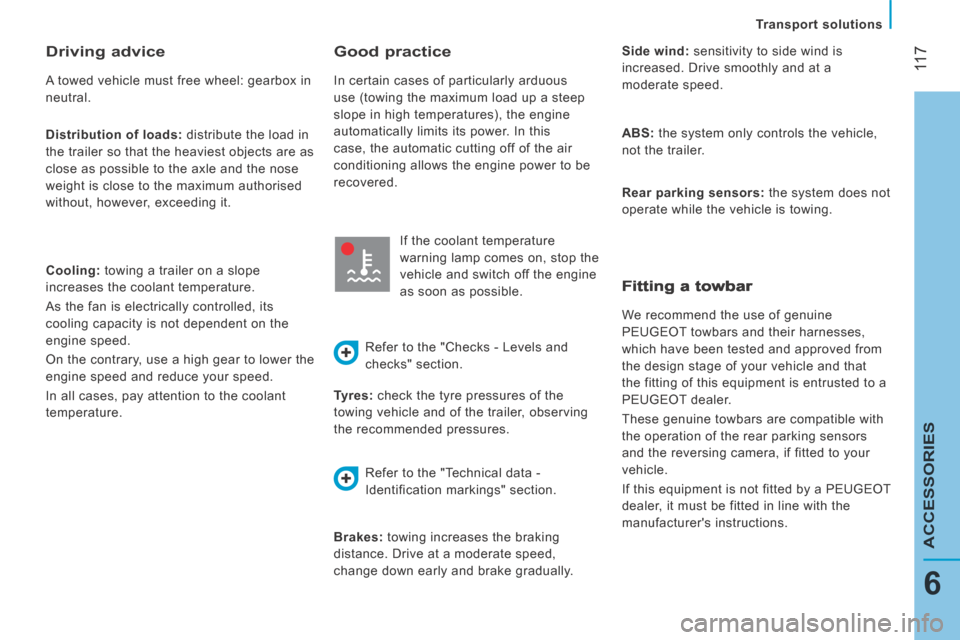
11 7
6
Transport solutions
ACCESSORIES
Distribution of loads: distribute the load in
the trailer so that the heaviest objects are as
close as possible to the axle and the nose
weight is close to the maximum authorised
without, however, exceeding it.
Driving advice
A towed vehicle must free wheel: gearbox in
neutral.
Cooling: towing a trailer on a slope
increases the coolant temperature.
As the fan is electrically controlled, its
cooling capacity is not dependent on the
engine speed.
On the contrary, use a high gear to lower the
engine speed and reduce your speed.
In all cases, pay attention to the coolant
temperature. Tyres: check the tyre pressures of the
towing vehicle and of the trailer, observing
the recommended pressures.
Fitting a towbar
We recommend the use of genuine
PEUGEOT towbars and their harnesses,
which have been tested and approved from
the design stage of your vehicle and that
the fitting of this equipment is entrusted to a
PEUGEOT dealer.
These genuine towbars are compatible with
the operation of the rear parking sensors
and the reversing camera, if fitted to your
vehicle.
If this equipment is not fitted by a PEUGEOT
dealer, it must be fitted in line with the
manufacturer's instructions.
Good practice
In certain cases of particularly arduous
use (towing the maximum load up a steep
slope in high temperatures), the engine
automatically limits its power. In this
case, the automatic cutting off of the air
conditioning allows the engine power to be
recovered.
If the coolant temperature
warning lamp comes on, stop the
vehicle and switch off the engine
as soon as possible.
Refer to the "Checks - Levels and
checks" section.
Brakes: towing increases the braking
distance. Drive at a moderate speed,
change down early and brake gradually. Side wind: sensitivity to side wind is
increased. Drive smoothly and at a
moderate speed.
ABS: the system only controls the vehicle,
not the trailer.
Rear parking sensors: the system does not
operate while the vehicle is towing.
Refer to the "Technical data -
Identification markings" section.